Liliang Ren
SAS: Simulated Attention Score
Jul 10, 2025Abstract:The attention mechanism is a core component of the Transformer architecture. Various methods have been developed to compute attention scores, including multi-head attention (MHA), multi-query attention, group-query attention and so on. We further analyze the MHA and observe that its performance improves as the number of attention heads increases, provided the hidden size per head remains sufficiently large. Therefore, increasing both the head count and hidden size per head with minimal parameter overhead can lead to significant performance gains at a low cost. Motivated by this insight, we introduce Simulated Attention Score (SAS), which maintains a compact model size while simulating a larger number of attention heads and hidden feature dimension per head. This is achieved by projecting a low-dimensional head representation into a higher-dimensional space, effectively increasing attention capacity without increasing parameter count. Beyond the head representations, we further extend the simulation approach to feature dimension of the key and query embeddings, enhancing expressiveness by mimicking the behavior of a larger model while preserving the original model size. To control the parameter cost, we also propose Parameter-Efficient Attention Aggregation (PEAA). Comprehensive experiments on a variety of datasets and tasks demonstrate the effectiveness of the proposed SAS method, achieving significant improvements over different attention variants.
Decoder-Hybrid-Decoder Architecture for Efficient Reasoning with Long Generation
Jul 09, 2025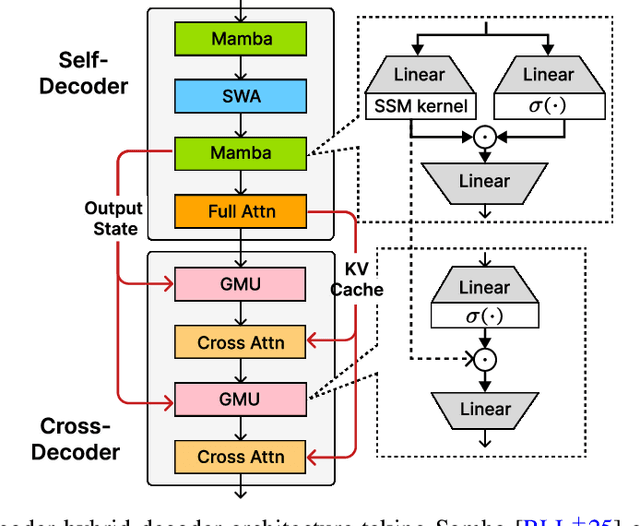

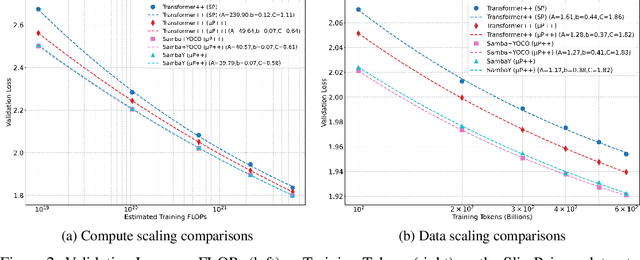

Abstract:Recent advances in language modeling have demonstrated the effectiveness of State Space Models (SSMs) for efficient sequence modeling. While hybrid architectures such as Samba and the decoder-decoder architecture, YOCO, have shown promising performance gains over Transformers, prior works have not investigated the efficiency potential of representation sharing between SSM layers. In this paper, we introduce the Gated Memory Unit (GMU), a simple yet effective mechanism for efficient memory sharing across layers. We apply it to create SambaY, a decoder-hybrid-decoder architecture that incorporates GMUs in the cross-decoder to share memory readout states from a Samba-based self-decoder. SambaY significantly enhances decoding efficiency, preserves linear pre-filling time complexity, and boosts long-context performance, all while eliminating the need for explicit positional encoding. Through extensive scaling experiments, we demonstrate that our model exhibits a significantly lower irreducible loss compared to a strong YOCO baseline, indicating superior performance scalability under large-scale compute regimes. Our largest model enhanced with Differential Attention, Phi4-mini-Flash-Reasoning, achieves significantly better performance than Phi4-mini-Reasoning on reasoning tasks such as Math500, AIME24/25, and GPQA Diamond without any reinforcement learning, while delivering up to 10x higher decoding throughput on 2K-length prompts with 32K generation length under the vLLM inference framework. We release our training codebase on open-source data at https://github.com/microsoft/ArchScale.
PaTH Attention: Position Encoding via Accumulating Householder Transformations
May 22, 2025Abstract:The attention mechanism is a core primitive in modern large language models (LLMs) and AI more broadly. Since attention by itself is permutation-invariant, position encoding is essential for modeling structured domains such as language. Rotary position encoding (RoPE) has emerged as the de facto standard approach for position encoding and is part of many modern LLMs. However, in RoPE the key/query transformation between two elements in a sequence is only a function of their relative position and otherwise independent of the actual input. This limits the expressivity of RoPE-based transformers. This paper describes PaTH, a flexible data-dependent position encoding scheme based on accumulated products of Householder(like) transformations, where each transformation is data-dependent, i.e., a function of the input. We derive an efficient parallel algorithm for training through exploiting a compact representation of products of Householder matrices, and implement a FlashAttention-style blockwise algorithm that minimizes I/O cost. Across both targeted synthetic benchmarks and moderate-scale real-world language modeling experiments, we find that PaTH demonstrates superior performance compared to RoPE and other recent baselines.
Phi-4-Mini-Reasoning: Exploring the Limits of Small Reasoning Language Models in Math
Apr 30, 2025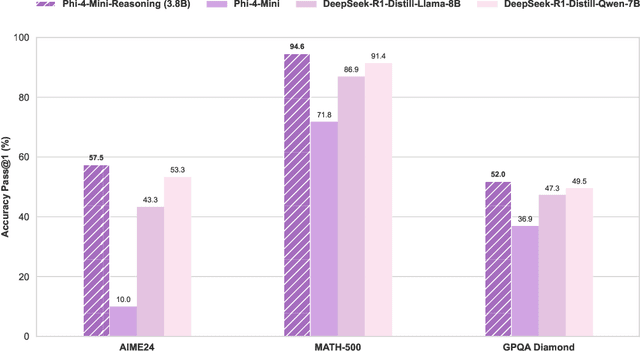


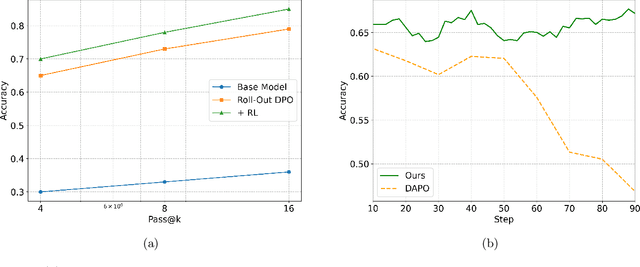
Abstract:Chain-of-Thought (CoT) significantly enhances formal reasoning capabilities in Large Language Models (LLMs) by training them to explicitly generate intermediate reasoning steps. While LLMs readily benefit from such techniques, improving reasoning in Small Language Models (SLMs) remains challenging due to their limited model capacity. Recent work by Deepseek-R1 demonstrates that distillation from LLM-generated synthetic data can substantially improve the reasoning ability of SLM. However, the detailed modeling recipe is not disclosed. In this work, we present a systematic training recipe for SLMs that consists of four steps: (1) large-scale mid-training on diverse distilled long-CoT data, (2) supervised fine-tuning on high-quality long-CoT data, (3) Rollout DPO leveraging a carefully curated preference dataset, and (4) Reinforcement Learning (RL) with Verifiable Reward. We apply our method on Phi-4-Mini, a compact 3.8B-parameter model. The resulting Phi-4-Mini-Reasoning model exceeds, on math reasoning tasks, much larger reasoning models, e.g., outperforming DeepSeek-R1-Distill-Qwen-7B by 3.2 points and DeepSeek-R1-Distill-Llama-8B by 7.7 points on Math-500. Our results validate that a carefully designed training recipe, with large-scale high-quality CoT data, is effective to unlock strong reasoning capabilities even in resource-constrained small models.
Reinforcement Learning for Reasoning in Large Language Models with One Training Example
Apr 29, 2025Abstract:We show that reinforcement learning with verifiable reward using one training example (1-shot RLVR) is effective in incentivizing the math reasoning capabilities of large language models (LLMs). Applying RLVR to the base model Qwen2.5-Math-1.5B, we identify a single example that elevates model performance on MATH500 from 36.0% to 73.6%, and improves the average performance across six common mathematical reasoning benchmarks from 17.6% to 35.7%. This result matches the performance obtained using the 1.2k DeepScaleR subset (MATH500: 73.6%, average: 35.9%), which includes the aforementioned example. Similar substantial improvements are observed across various models (Qwen2.5-Math-7B, Llama3.2-3B-Instruct, DeepSeek-R1-Distill-Qwen-1.5B), RL algorithms (GRPO and PPO), and different math examples (many of which yield approximately 30% or greater improvement on MATH500 when employed as a single training example). In addition, we identify some interesting phenomena during 1-shot RLVR, including cross-domain generalization, increased frequency of self-reflection, and sustained test performance improvement even after the training accuracy has saturated, a phenomenon we term post-saturation generalization. Moreover, we verify that the effectiveness of 1-shot RLVR primarily arises from the policy gradient loss, distinguishing it from the "grokking" phenomenon. We also show the critical role of promoting exploration (e.g., by adding entropy loss with an appropriate coefficient) in 1-shot RLVR training. As a bonus, we observe that applying entropy loss alone, without any outcome reward, significantly enhances Qwen2.5-Math-1.5B's performance on MATH500 by 27.4%. These findings can inspire future work on RLVR data efficiency and encourage a re-examination of both recent progress and the underlying mechanisms in RLVR. Our code, model, and data are open source at https://github.com/ypwang61/One-Shot-RLVR
Phi-4-Mini Technical Report: Compact yet Powerful Multimodal Language Models via Mixture-of-LoRAs
Mar 03, 2025Abstract:We introduce Phi-4-Mini and Phi-4-Multimodal, compact yet highly capable language and multimodal models. Phi-4-Mini is a 3.8-billion-parameter language model trained on high-quality web and synthetic data, significantly outperforming recent open-source models of similar size and matching the performance of models twice its size on math and coding tasks requiring complex reasoning. This achievement is driven by a carefully curated synthetic data recipe emphasizing high-quality math and coding datasets. Compared to its predecessor, Phi-3.5-Mini, Phi-4-Mini features an expanded vocabulary size of 200K tokens to better support multilingual applications, as well as group query attention for more efficient long-sequence generation. Phi-4-Multimodal is a multimodal model that integrates text, vision, and speech/audio input modalities into a single model. Its novel modality extension approach leverages LoRA adapters and modality-specific routers to allow multiple inference modes combining various modalities without interference. For example, it now ranks first in the OpenASR leaderboard to date, although the LoRA component of the speech/audio modality has just 460 million parameters. Phi-4-Multimodal supports scenarios involving (vision + language), (vision + speech), and (speech/audio) inputs, outperforming larger vision-language and speech-language models on a wide range of tasks. Additionally, we experiment to further train Phi-4-Mini to enhance its reasoning capabilities. Despite its compact 3.8-billion-parameter size, this experimental version achieves reasoning performance on par with or surpassing significantly larger models, including DeepSeek-R1-Distill-Qwen-7B and DeepSeek-R1-Distill-Llama-8B.
BAP v2: An Enhanced Task Framework for Instruction Following in Minecraft Dialogues
Jan 18, 2025Abstract:Interactive agents capable of understanding and executing instructions in the physical world have long been a central goal in AI research. The Minecraft Collaborative Building Task (MCBT) provides one such setting to work towards this goal (Narayan-Chen, Jayannavar, and Hockenmaier 2019). It is a two-player game in which an Architect (A) instructs a Builder (B) to construct a target structure in a simulated Blocks World Environment. We focus on the challenging Builder Action Prediction (BAP) subtask of predicting correct action sequences in a given multimodal game context with limited training data (Jayannavar, Narayan-Chen, and Hockenmaier 2020). We take a closer look at evaluation and data for the BAP task, discovering key challenges and making significant improvements on both fronts to propose BAP v2, an upgraded version of the task. This will allow future work to make more efficient and meaningful progress on it. It comprises of: (1) an enhanced evaluation benchmark that includes a cleaner test set and fairer, more insightful metrics, and (2) additional synthetic training data generated from novel Minecraft dialogue and target structure simulators emulating the MCBT. We show that the synthetic data can be used to train more performant and robust neural models even with relatively simple training methods. Looking ahead, such data could also be crucial for training more sophisticated, data-hungry deep transformer models and training/fine-tuning increasingly large LLMs. Although modeling is not the primary focus of this work, we also illustrate the impact of our data and training methodologies on a simple LLM- and transformer-based model, thus validating the robustness of our approach, and setting the stage for more advanced architectures and LLMs going forward.
Samba: Simple Hybrid State Space Models for Efficient Unlimited Context Language Modeling
Jun 11, 2024
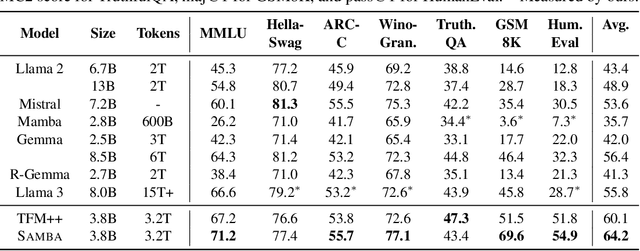

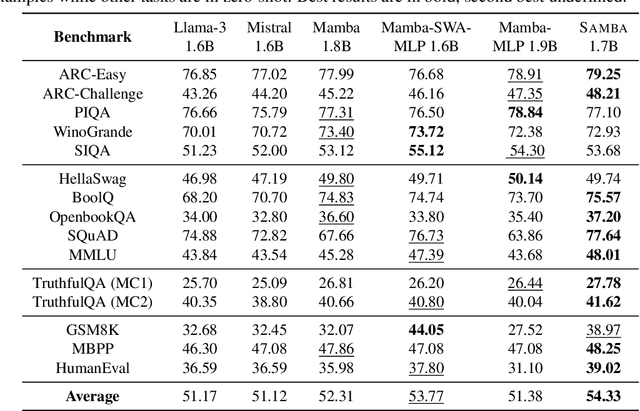
Abstract:Efficiently modeling sequences with infinite context length has been a long-standing problem. Past works suffer from either the quadratic computation complexity or the limited extrapolation ability on length generalization. In this work, we present Samba, a simple hybrid architecture that layer-wise combines Mamba, a selective State Space Model (SSM), with Sliding Window Attention (SWA). Samba selectively compresses a given sequence into recurrent hidden states while still maintaining the ability to precisely recall memories with the attention mechanism. We scale Samba up to 3.8B parameters with 3.2T training tokens and show that Samba substantially outperforms the state-of-the-art models based on pure attention or SSMs on a wide range of benchmarks. When trained on 4K length sequences, Samba can be efficiently extrapolated to 256K context length with perfect memory recall and show improved token predictions up to 1M context length. As a linear-time sequence model, Samba enjoys a 3.73x higher throughput compared to Transformers with grouped-query attention when processing user prompts of 128K length, and 3.64x speedup when generating 64K tokens with unlimited streaming. A sample implementation of Samba is publicly available in https://github.com/microsoft/Samba.
Sparse Modular Activation for Efficient Sequence Modeling
Jul 11, 2023



Abstract:Linear State Space Models (SSMs) have demonstrated strong performance in a variety of sequence modeling tasks due to their efficient encoding of the recurrent structure. However, in more comprehensive tasks like language modeling and machine translation, self-attention-based models still outperform SSMs. Hybrid models employing both SSM and self-attention generally show promising performance, but current approaches apply attention modules statically and uniformly to all elements in the input sequences, leading to sub-optimal quality-efficiency trade-offs. In this work, we introduce Sparse Modular Activation (SMA), a general mechanism enabling neural networks to sparsely and dynamically activate sub-modules for sequence elements in a differentiable manner. Through allowing each element to skip non-activated sub-modules, SMA reduces computation and memory consumption at both training and inference stages of sequence modeling. As a specific instantiation of SMA, we design a novel neural architecture, SeqBoat, which employs SMA to sparsely activate a Gated Attention Unit (GAU) based on the state representations learned from an SSM. By constraining the GAU to only conduct local attention on the activated inputs, SeqBoat can achieve linear inference complexity with theoretically infinite attention span, and provide substantially better quality-efficiency trade-off than the chunking-based models. With experiments on a wide range of tasks, including language modeling, speech classification and long-range arena, SeqBoat brings new state-of-the-art results among hybrid models with linear complexity and reveals the amount of attention needed for each task through the learned sparse activation patterns.
C-PMI: Conditional Pointwise Mutual Information for Turn-level Dialogue Evaluation
Jun 27, 2023
Abstract:Existing reference-free turn-level evaluation metrics for chatbots inadequately capture the interaction between the user and the system. Consequently, they often correlate poorly with human evaluations. To address this issue, we propose a novel model-agnostic approach that leverages Conditional Pointwise Mutual Information (C-PMI) to measure the turn-level interaction between the system and the user based on a given evaluation dimension. Experimental results on the widely used FED dialogue evaluation dataset demonstrate that our approach significantly improves the correlation with human judgment compared with existing evaluation systems. By replacing the negative log-likelihood-based scorer with our proposed C-PMI scorer, we achieve a relative 60.5% higher Spearman correlation on average for the FED evaluation metric. Our code is publicly available at https://github.com/renll/C-PMI.
 Add to Chrome
Add to Chrome Add to Firefox
Add to Firefox Add to Edge
Add to Edge